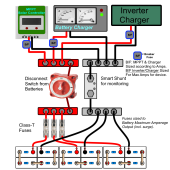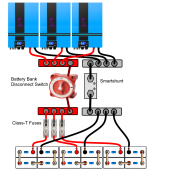You would think that circuit protection would be fairly Stright forward, right??
well, I am finding it a worse task than choosing the right inverter/charger!!
so, I am trying to build some protection from my four rack batteries to my inverter. (eack rack battery is 48v 100a)
Two wires going from my rack cabinet busbar to my inverter charger, quite basic, but the problem lies in finding the correct protection,
I've read that due to possible huge discharge currents, some fuses if blown can form an arc, and it's very difficult to close that arc, and hence why some fuses are filled with silica to distinguish that arc. OK I follow that bit, but then on some spec sheets certain fuses state a 48W loss !!!! what's that all about?? are they saying using there fuse I will lose 48w as some kind of usage loss ???
breakers are a topic in them self's again,
you struggle to find a suitable breaker for my size of system BUT THEN realise that as I have a inverter/charger, the breaker will see current passing in both direction!!
more head damage finding a suitable breaker.
I want my mummy lol lol
well, I am finding it a worse task than choosing the right inverter/charger!!
so, I am trying to build some protection from my four rack batteries to my inverter. (eack rack battery is 48v 100a)
Two wires going from my rack cabinet busbar to my inverter charger, quite basic, but the problem lies in finding the correct protection,
I've read that due to possible huge discharge currents, some fuses if blown can form an arc, and it's very difficult to close that arc, and hence why some fuses are filled with silica to distinguish that arc. OK I follow that bit, but then on some spec sheets certain fuses state a 48W loss !!!! what's that all about?? are they saying using there fuse I will lose 48w as some kind of usage loss ???
breakers are a topic in them self's again,
you struggle to find a suitable breaker for my size of system BUT THEN realise that as I have a inverter/charger, the breaker will see current passing in both direction!!
more head damage finding a suitable breaker.
I want my mummy lol lol







